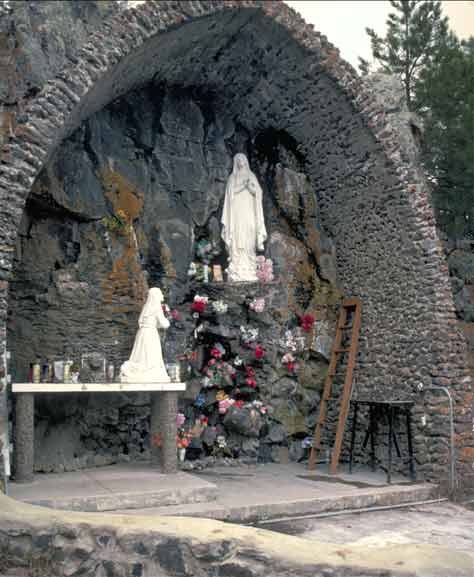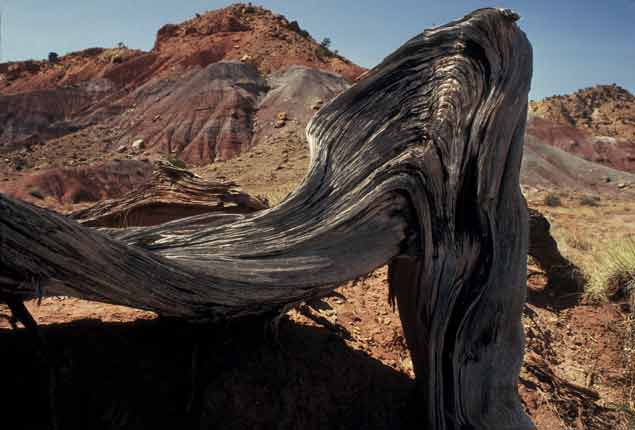|
Monotheism in
the Desert:
I doubt that monotheism could arise in a lush jungle, where everything
is obviously closely connected, where the birds and animals jabber all
night long, where rain comes daily and food is not scarce.
Monotheism must have occurred to some simple-minded individual, in the
desert, late at night. Cold, hungry, endangered by lions and
jackals, and with the only sound the insidious hiss of silence, this
person, looking at the immense sky above and the flat, sterile land
around, found the keys to monotheism:
a) There is only one God.
b) He doesn't give a rat's ass about you.
Actually, there is no such thing as a monotheistic religion.
I'm
extrapolating back to an imaginary Ur-founder of Judaism, Christianity
and Islam. Even the most fundamentalist Jews, those who dare not
say JHVH but must use
euphemisms, believe in Satan and Dybbuks and Angels, and if they're not
gods, I'll eat my red hat. If you want to attain deity, you need
only three things: Immortality, Supernatural Powers, and
Presence. Notice that omniscience is not necessary, although it
would help to have more knowledge than mere mortals. And
omnipotence doesn't exist, even for Jehovah, or he would have mopped up
the floor with Satan long ago. Omnipresence isn't necessary,
either, although Presence, an individually felt Presence, is.
That's a problem for the ideal monotheistic God: He's spread himself
too thin, and by achieving omnipresence, he's got so far away that he
can't be reached without the aid of helpers. Not to be outdone,
Satan needs helpers, too. I don't know much about Islam, except
that, like Judaism, they at least have angels and demons.
Christianity started with a trio of gods: God as Jehovah, the Remote
Father; God in the human aspect of Jesus, who intercedes with Jehovah
on our behalf; and God the Holy Spirit, which I interpret as the
much-needed personal Presence of God: the aspect of God that makes you
see visions, speak in tongues, and whirl like a Dervish. I'm not
affected by the sophism that they're really one god: I can count on my
fingers as well as the next person. As a proselytizing religion,
Christianity quickly found out it would go nowhere with the Heathens
without adding some more gods, mainly the Holy Virgin, who is not only
immortal, but went to heaven body and all. Therefore, she's not
just an ordinary spiritual goddess, but a corporeal being, capable of
making personal appearances, like Elvis. The Roman Catholic
Church, modeling itself on the Roman Empire, created a complicated
hierarchy of popes, cardinals, archbishops, bishops, and priests for
this world, and, in justification, constructed a parallel heavenly
hierarchy: if I remember right, the angels by themselves are organized
into seven bureaucratic levels, followed by the saints. The
Vatican recently cleaned house, defrocking thousands of saints, and
sent them out of the House of God. Even Saint Christopher, the
patron saint of fast cars, got laid off. I worry that these
disgruntled saints will try to get a job with Satan, possibly tipping
the delicate balance of power onto the wrong side.
It is here, I believe, where the flock shows more sense than
the
shepherds. The larger supermarkets in New Mexico have a whole
section devoted to votive candles. These are not the puny ones
you see in northern stores, but wax-filled tumblers the size of a rum
drink in a pseudo-Polynesian restaurant. Each candle has a
picture of the saint, its name, and a suggested prayer to the saint,
both in English and Spanish. The Virgin Mary appears in many
guises, as pure mother, as Lady of Pain, as Lady of Sorrows, Lady of
Mercy, etc. St. Jude, the patron saint of Lost Causes, is of
course prominently featured and amply stocked, but so are a lot of the
defrocked saints. If you want to commit a venial sin, you can buy
one of these candles and say a prayer to an unemployed saint. It
may not do you much good, but it will certainly make the saint feel
better. Some of the other saints were on horseback, and one was a
little girl -- well, presumably still is a little girl, since saints
don't age. I didn't take the time to read the prayer to her, but
now I wish I had, since I don't know what you'd ask of such a
saint. The prayers I did read, however, all followed about the
same formula, and were aimed at those who feel themselves deprived, not
by Satan, but by life itself. The typical prayer had portions
that you had to fill in for yourself:
"Oh holy Saint (blank), you know how abject and poor I am,
and how
(blank) I am, and how I need (blank). Please hear my
supplications in this time of trouble and help me to (blank).
Thank you."
None of the tumblers have any suggested prayers dealing with
thanking a
deity for blessings already received, or boundless wealth due to
winning the lottery, or easy victories over formidable foes. I
don't think the case is exactly that New Mexican Catholics are an
ungrateful lot; it's just that this isn't the Land of Milk and Honey,
and, in any event, human wants always exceed supply.
I could go on at equal length about Protestants, who boast in
the
old
ballad The Romish Lady
that they
cannot worship angels or pictures made by man,
but
they're
more pitiful, because more imagery impoverished, than the Mexican
Catholics. Still, they have the Holy Trinity and Satan with his
Demons, and many of the angels. Gabriel, for example, is hanging
around, waiting to announce Judgment Day. You'd think he could
find some way to make himself useful while waiting. But, then
again, no one's lighting any candles to him.
I said at the beginning of this tirade that gods need
immortality,
supernatural powers, and presence. Immortality is the tricky
part, because they can achieve it only if they can get humans to
continue to worship them. They have devised a survival strategy,
but at quite a cost: they have to change with the times. They
have to change their names, their physical appearance, sometimes they
even have to have sex-change operations. That's quite a price for
immortality.
|
 |

